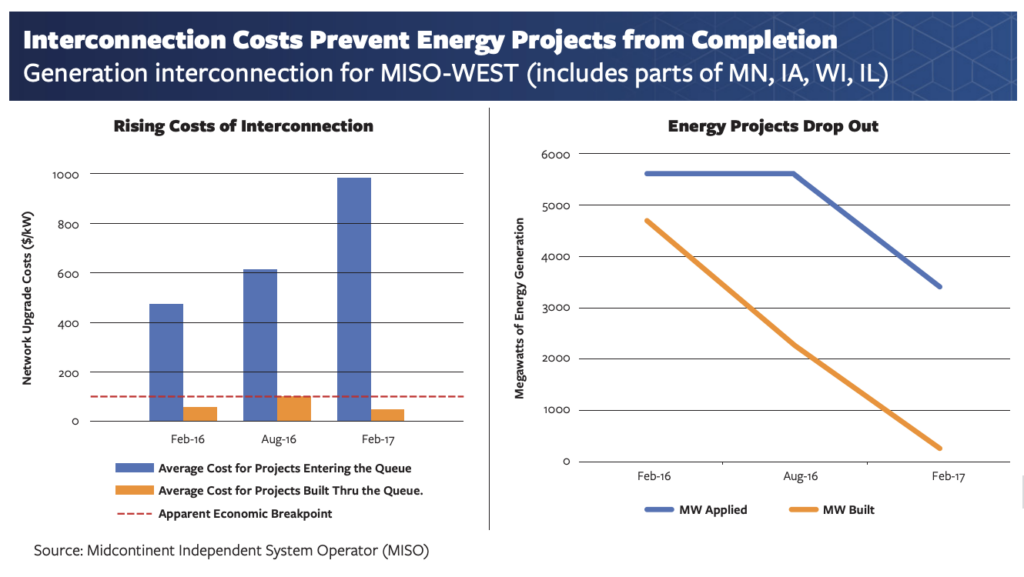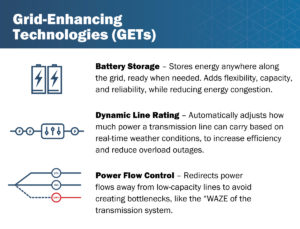July 19, 2021
Bridging Gaps in the Grid
Removing financial hurdles to building a modern clean energy system.
Clean energy is a growing source of electricity generation across the country. But the old grid wasn’t designed to make the most of new renewable resources. As Congress maps out new infrastructure opportunities, it is critical to ensure smart policies and investments to achieve an efficient and holistic energy delivery system. In addition to building new transmission lines where needed, smart technology can enhance the performance of the existing grid, reduce costs and congestion, and get clean energy online faster. A new bill, the Efficient Grid Interconnection Act of 2021 introduced by Representative Kathy Castor, would do just that by adjusting financial incentives to take advantage of new technology to meet the energy needs of the future.
Interconnection Impediments

Image 1: Regional Transmission Operators (RTOs) and Independent Service Operators (ISOs) in the United States.
Before any wind, solar, battery storage, or other energy project can join the grid, it must go through a process called “generator interconnection” to assess whether the existing infrastructure can handle the new energy, or if upgrades are needed. In the Midwest, this process is done by one of two Regional Transmission Operators (RTOs): MISO or PJM (see image 1).
If there are problems with adding the generator to the system (a common situation), the RTO will identify solutions that can range from upgrading existing lines and substations to installing new lines and equipment. The costs of these upgrades can be many millions of dollars and the interconnecting clean generator is on the hook for it. However, requiring the generators to pay for these upgrades can quickly torpedo otherwise economically viable projects. This is a growing problem in several places across the U.S. where people are trying to build new clean energy projects, but the growing costs of interconnection are too high, so they cannot follow through (see image 2).

Image 2: Interconnection Costs Prevent Energy Projects from Completion
Cost Allocation Complications
Federal courts have consistently interpreted the Federal Power Act (FPA) to require that the costs of transmission upgrades be paid for by “cost causers and beneficiaries” in a process known as “cost allocation.” Proper cost allocation is important because transmission upgrades are often very expensive and cannot be effectively born by any single business or individual. By allocating costs to both causers and beneficiaries, the FPA encourages valuable upgrades to the transmission grid that would otherwise not be built if the costs were paid by a single entity. It’s a way to provide a public good, and it is the financial backbone of the grid.
In the case of interconnection, however, the use of the cost causers and beneficiaries test has broken down. In its simplest form, the current method of allocating costs only to interconnecting customers is focusing solely on the “cost causers” side of the cost allocation equation while ignoring the “beneficiaries” side. While it is true that in some sense the interconnecting generators are the proximate cause of the need for the transmission, they are certainly not the only beneficiaries.
Transmission upgrades bolster the grid, benefitting a range of end-use customers who get more stable and reliable electricity. What’s more, customers benefit from the low-cost electricity and bolstered reliability created by adding renewables to the grid. These benefits are currently ignored in the interconnection cost allocation process. Finally, renewable generation brings air quality, public health, environmental, and climate benefits that can and should be considered in the cost allocation process.
New Bill Could Help Fix the Flaws
Thankfully, Representative Kathy Castor’s Efficient Grid Interconnection Act of 2021 would require the Federal Energy Regulatory Commission (FERC) to significantly improve cost allocation for interconnecting renewable and storage generators. Under Castor’s bill, RTOs would need to properly identify the cost causers and beneficiaries of grid upgrades required for interconnection and allocate those costs accordingly. Crucially, the bill requires the cost allocation process to include not only quantifiable benefits to parties in terms of usage and reduced electricity costs, but also those benefits that cannot be directly quantified, such as resilience and environmental benefits.
 In addition to the change in cost allocation, the Castor bill also notes the benefits that Grid Enhancing Technologies (GETs) such as power flow control, dynamic line rating, storage, and topology optimization can bring to quickly and cheaply interconnecting renewable generation. The bill requires the RTO to consult with transmission owners to identify where GETs could be used in the interconnection process. While the bill does not go so far as to require that RTOs to implement GETs whenever possible, it does allow the renewable generator to request the use of GETs where possible. This is a good first step toward fully integrating GETs into the planning process and should be expanded into the transmission planning more broadly.
In addition to the change in cost allocation, the Castor bill also notes the benefits that Grid Enhancing Technologies (GETs) such as power flow control, dynamic line rating, storage, and topology optimization can bring to quickly and cheaply interconnecting renewable generation. The bill requires the RTO to consult with transmission owners to identify where GETs could be used in the interconnection process. While the bill does not go so far as to require that RTOs to implement GETs whenever possible, it does allow the renewable generator to request the use of GETs where possible. This is a good first step toward fully integrating GETs into the planning process and should be expanded into the transmission planning more broadly.
Climate change is already shaping our world rapidly, causing extreme heat waves in the west, flooding in the east, and stronger storms right here in the heartland, among other impacts. We cannot afford to let our outdated transmission system and dysfunctional planning process hold us back from ramping up clean energy solutions. ELPC’s Beyond Wires Coalition is working to ensure that transmission and distribution-connected technologies are fully considered and optimally deployed to maximize the cost-effective delivery of renewable electricity while maintaining reliability.


